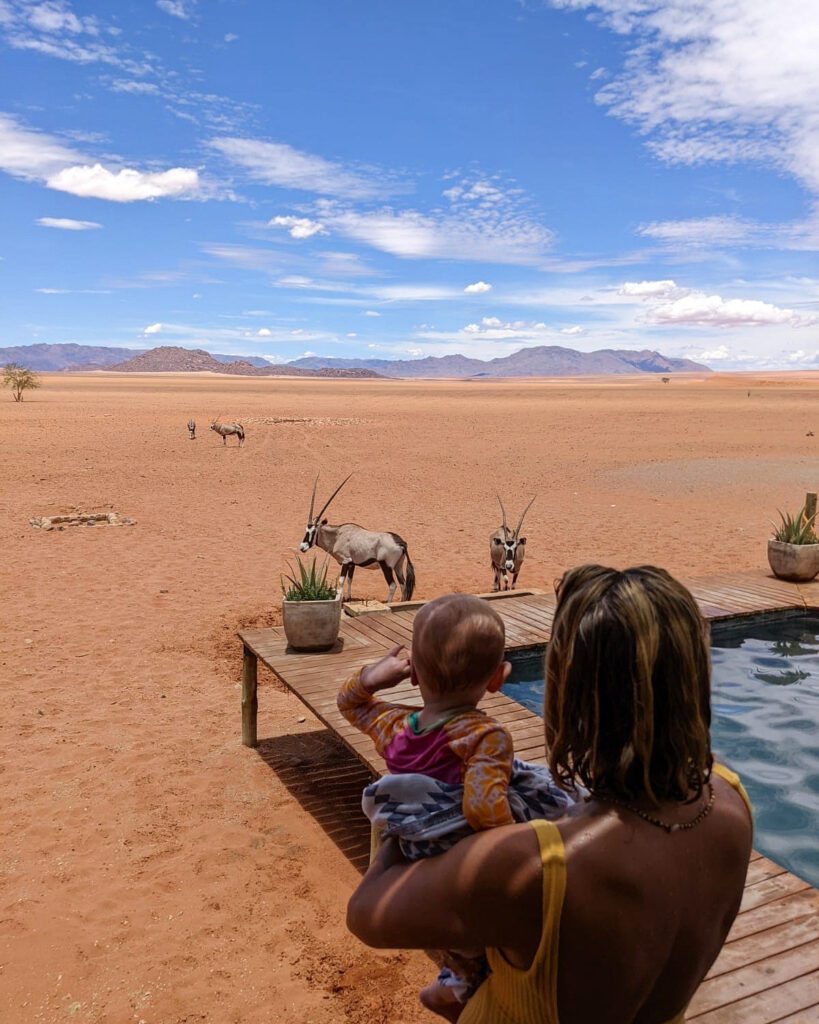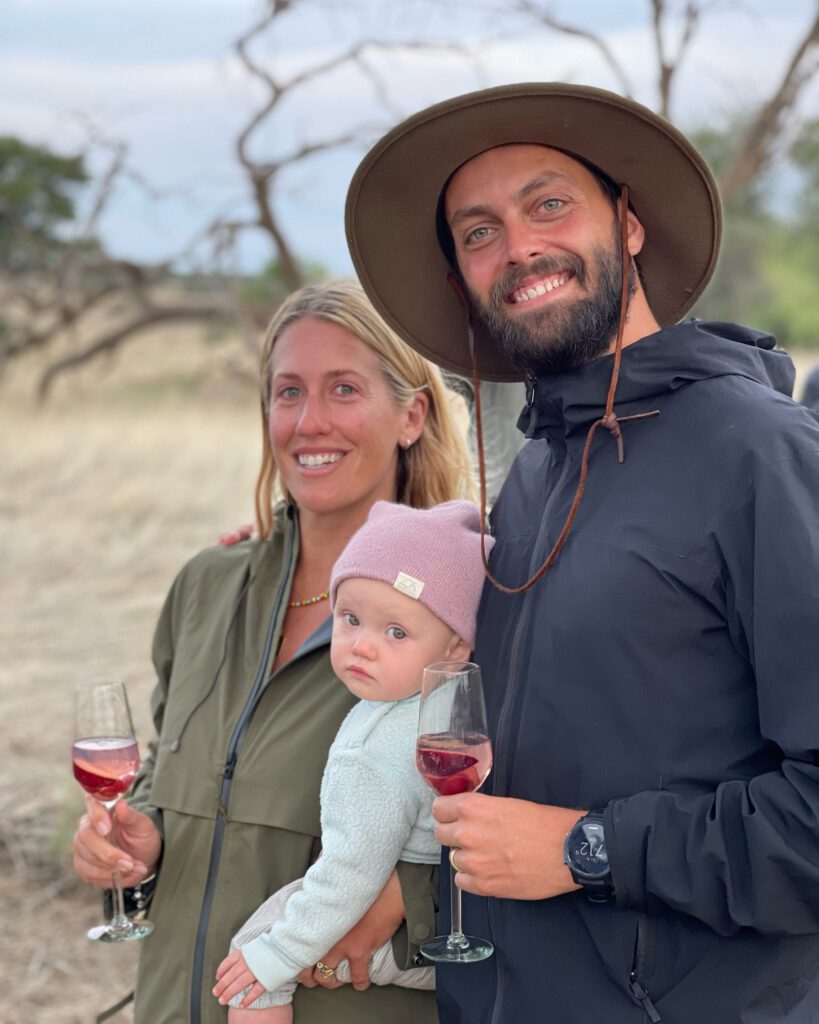I can’t see anything but sand and sky. I’m staring into an abyss of pale blue and khaki tan, but with delicate texture, like the fingerprint-like tracks left by an elephant walking slowly across soft earth. If I turn around in my petite Scenic Air prop plane bucket seat, however, I can just make out the sliver of emerald Atlantic Ocean bleeding into the horizon. Gazing downward, out the window, I watch the endless dunes of the Namib Desert slowly saturate with a pinkish hue as we move inland—away from the defunct diamond mines, away from the shipwrecks that have become homes for jackals, away from flamboyances of flamingos and colonies of seals at the edge of the scalloped sea.
I catch sight of the Witberg (or White Mountain) and feel as though we’ve entered a fairytale. “I feel like my eyes are playing tricks on me,” I say through the headset. “The desert will do that to you,” replies our pilot, Anthony, who’s flying us 2,500 feet above the increasingly pinkish-orange dunes which, to me, feels like being on the verge of heaven. A white ribbon curls between crests of sand that give way to fine peaks. The only word I can think is surreal. But this unique topography that seems so ephemeral has actually been around for some five million years. This ancient landscape below us is Sossusvlei, one of the most iconic destinations in Namibia, a country with astounding geographic diversity.
Sossusvlei is all salt, clay, and sand, with remarkable red dunes arching and curling seemingly forever. The popular tourist attraction is in the southern part of the Namib Desert and is part of the Namib Sand Sea UNESCO World Heritage Site. It’s also one of the most breathtaking sites I know of in the world to observe from the air, like we are doing via a thrilling scenic flight from Swakopmund, though we started farther north in Damaraland. But it’s also a site that requires more than just a flyover.

The desert is full of surprises, and our arrival coincides with a sandstorm that feels very Mad Max (a The desert is full of surprises, and our arrival coincides with a sandstorm that feels very Mad Max (a movie that was filmed in Namibia!). Feet firmly planted on terra firma, we check into Kwessi Dunes and immediately decide that we’re going to make the 90-minute journey to Sossusvlei by road two mornings later. That is, after we’ve settled into our canvas-sided, thatched-roof accommodation and had the opportunity to take a couple slow-motion drives around the NamibRand Nature Reserve, in which this new lodge sits dune-side. (Sadly, we never make use of our outdoor bedroom, aka star bed, since it rains each evening of our stay in this Dark Sky Reserve, but the outdoor shower is an enjoyable perk.) Bradley, our binocular-armed guide, has worked in this singular part of Namibia for years and can elaborate on rainfall patterns just as well as he can ostrich grass, Rüppell’s Korhaan birds, and oryx behavior. He explains that iron oxidation is to thank for the rusty red environment surrounding us, one that lights up to psychedelic neon in the afternoon setting sun yet appears unbelievably subtle—blush almost—in the soft morning light.
There’s none of that when we depart for Sossusvlei, climbing into the closed safari vehicle before dawn for an incredibly flat yet bumpy trip atop dove gray earth. As he drives, Bradley tells us about how the place earned its name. In the Nama language, sossus means dead end, and vlei is Afrikaans for marsh. Soon after we enter the gate, unearthly palettes and sublime shapes emerge. We drive deeper into Sossusvlei, passing several ostrich and oryx along the corridor between shapely mountains of sand sculpted by both easterly and westerly winds, surprisingly dynamic and varied in hue, peaches to deep corals and even rich reds. (Note there is typically a long queue of vehicles waiting each morning, but due to the pandemic we drove straight through a bit after 7 a.m.)
The dunes exceeding 100 meters in height have either names or numbers, and we stop by Dune 1 first, then Dune 45. As the most photographed, it’s arguably the most famous. And 45 is a beautiful specimen, but our sights are on Big Daddy at a whopping 1,066 feet. “Onto the adventure,” Bradley says as we reach the end of the paved road. “This is where you will experience the African massage,” he adds with a smile.
By the time we crunch our way to the base of Big Daddy it’s 8:40 am—late by normal standards. But these aren’t average circumstances; the pandemic has slowed the flow of would-be climbers considerably, and we’re also lucky to have chosen an unseasonably mild morning. We almost have the dune to ourselves. Typically, Bradley says, there are lines of tourists attempting the climb that feels like being on a stairclimber dissolving with each step. He advises trying to walk in the last person’s footprints for an easier go. Easy is a relative term, I realize, when climbing the vertebra-like ridge of a giant pile of sand. I’m huffing and puffing, sweating and sucking air as I go—but I fortunately don’t collapse belly down like two women below.
Still, it’s tricky at times to keep my balance on this knife’s edge—especially while savoring the otherworldly panoramas that make this sand sea just so legendary. At one point, Bradley points to a tiny lizard a couple feet away, and tells me to watch for it to dive into the pristine sand. Eventually it does, disappearing completely! Yet it won’t suffocate, he explains, since this sand is actually minuscule rocks padded with plenty of oxygen. And grueling as the journey is, I won’t either. When we do reach the peak 55 minutes later, I feel an incredible sense of accomplishment and turn around and around, taking in the unbelievable wonders at my feet.
But there are others on their way up, so we should make space. Bradley and my husband, Keith, wearing our 11-month-old daughter on his chest, suddenly move to our right, where an absurdly steep slope ends But there are others on their way up, so we should make space. Bradley and my husband, Keith, wearing our 11-month-old daughter on his chest, suddenly move to our right, where an absurdly steep slope ends in what looks like an off-white pond. “Wait, what?” I ask, legitimately confused. “We’re going down that?” My husband laughs. “How else would we get down?!”
I’d been warned that I shouldn’t take a phone or camera with me up Big Daddy unless I planned to never use them again. But Bradley had assured me I could make the trek without a device-killing infusion of sand. Now he explains the technique for our descent: dig heels in and lean back. Way back. They head down at a steady clip while I mentally prepare to not tumble down or face plant. As it turns out, going down is incredibly fun, what I imagine it to feel like walking in space—or maybe clouds. I bounce, feeling weightless, every single footstep squeaking, sand spilling into my socks and creating little dunes molded to the arches of my feet. I don’t want to it to end, so I go slow, really slow. Plus, the views are extraordinary.

At the base is another dreamlike scene: Deadvlei, where 900-year-old bare, dead acacia erioloba trees twist out of cracked white clay. By then I am tinted red, sand everywhere, fingernails to eyelashes. Our little one is covered, too, letting the brick-colored sand slide through her fingers. “Well Indah,” my husband says, “Your sandbox is arguably cooler than most kids’.” We walk across the expanse in quiet amazement—there is no one else around, except ant-sized people making their own astronaut-like descents down the monumental wall of red. This, Bradley assures us, is not normal for Sossusvlei. Even more reason to revel in it.
I’m starving and exhausted by the time we reach the truck; Bradley drives us quickly to a picnic table under a gnarled tree, spreads out a cloth and lays out our picnic brunch—fruit salad, cereal, cheeses and meats, hard-boiled eggs, juice, coffee and hot chocolate. It all tastes better after an achievement of this magnitude—and in this setting, embraced by these prehistoric dunes. Of course, they’re not static. Their cores are petrified, but their loose exteriors shape shift due to the elements, yes, but also tourists like us. During the pandemic, Bradley tells us, sand nearly covered a several-foot-tall sign, there were so few people tromping around it.

If we came back in a year this incredible stretch of sand sculptures would appear different. The climb would be a fresh experience. The zebra dazzle crowding around Kwessi Dunes’ water hole in the late afternoon might not appear, and the black-backed jackal that drinks solo and then runs below my feet under the large wooden deck may have moved on. These moments on this day are one of a kind. I certainly have never seen a purple-tinged sunset take over the sky like it does that night, as we sip pink G&Ts with Copper & Coal Distillery Desolate gin featuring Namibian botanicals. It’s terrifyingly beautiful, which feels an apt description of Namibia, somehow: astonishingly gorgeous yet a little bit trying, with a dIf we came back in a year this incredible stretch of sand sculptures would appear different. The climb would be a fresh experience. The zebra dazzle crowding around Kwessi Dunes’ water hole in the late afternoon might not appear, and the black-backed jackal that drinks solo and then runs below my feet under the large wooden deck may have moved on. These moments on this day are one of a kind. I certainly have never seen a purple-tinged sunset take over the sky like it does that night, as we sip pink G&Ts with Copper & Coal Distillery Desolate gin featuring Namibian botanicals. It’s terrifyingly beautiful, which feels an apt description of Namibia, somehow: astonishingly gorgeous yet a little bit trying, with a dash of unknown to keep you on your toes. It’s for these reasons I will forever be drawn back into its orbit.
Kathryn Romeyn is a travel and design journalist living in Los Angeles and Bali. She co-hosts Conscious Traveler, a podcast inspiring meaningful exploration through stories of culture, conservation, and community. Kathryn packs her Canon DSLR for every trip and seeks out remarkable landscapes and wildlife, Neapolitan-style pizza, and long, left-handed waves.











